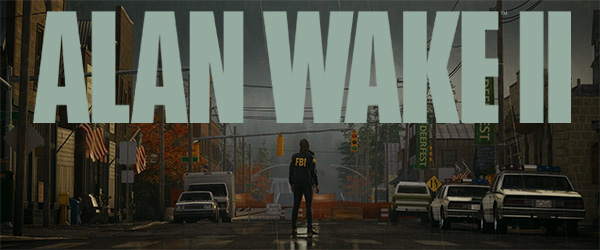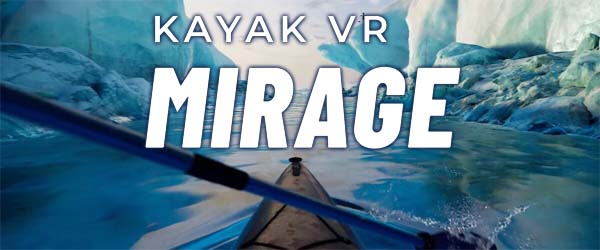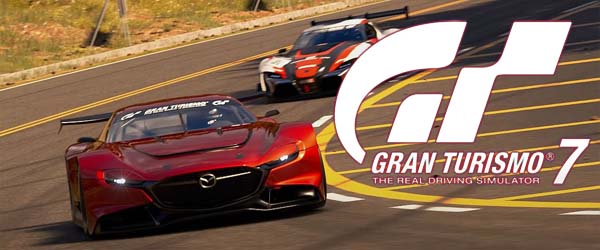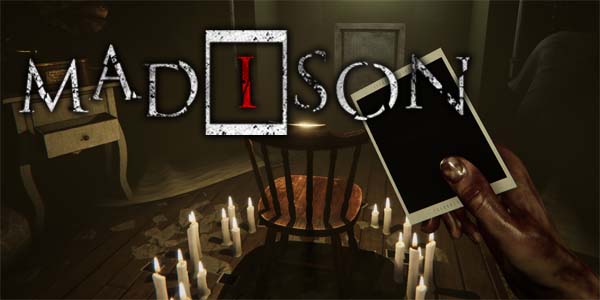
I'll give Remedy this bit of credit: in a world overrun with soul-less, design-by-committee, live-services and vehicles for micro-transaction economies, Alan Wake 2 is a game that actually has a strong creative vision and personality. It follows in the footsteps of Hideo Kojima and Death Stranding by being completely confident in itself and being un-abashedly weird. And just like with Death Stranding, that means that sometimes Alan Wake 2 is genius; other times it's confoundingly stupid and hackneyed!
It's hard even to classify Alan Wake 2 into a single genre. That goes for both narrative genre and also ludic genre. In both cases, it's kind of all over the place. At the most reductionist level, it follows the basic formula of a modern horror game: exploring creepy environments to find keys for doors, fighting monsters as an over-the-shoulder 3rd-person shooter, solving puzzles, and managing a limited inventory. So it's a "horror game", right? In fact, sometimes, it's seriously scary and disturbing. But other times, I'm questioning its "horror" status while I'm laughing out loud to a deliberate joke, or bored out of my mind because nothing scary or particularly exciting has happened in hours. Yet other times still, it's farcically campy or schlocky, and un-intentionally laughable. It's story is ridiculously out there in its concepts and execution, but somehow every beat of the plot is set up and signposted as clearly and obviously as the neon signs that point the player to the next objective in the Dark Place.
Plot twists are signposted more clearly and obviously than the neon signs that often guide the player through levels.
It's also frequently up its own ass. It is, after all, a fictional story about the power of fiction to alter reality (and our perception of reality). It even features the lead designer as a self-insert character within the story. Though surprisingly, he made himself a secondary character instead of one of the 2 playable protagonists. So it's not really about him, but he still found a way to make the entire plot revolve around that secondary character.
In the mind's eye
I feel that Alan Wake 2 is consistently at its best when its sitting firmly in its horror-mystery mode. As such, the opening couple hours of the game really pulled me in and hooked me. The game's main quest and side content are split up into various "cases" for the FBI agent protagonists to solve. There's a mechanic in which the player can retreat into Agent Saga Anderson's "Mind Space", which is an imaginary office room in which she sorts through all the clues she's gathered and strings them together on an imaginary wall in order to fit the puzzle pieces of the mystery together. Each time the player discovers a critical piece of information in the game world, it will show up in the Mind Space's filing cabinet as a new file in a case folder. Putting the clues together in the right way will unlock new lines of inquiry, and can even reveal the next objective.
Agent Anderson can review the known evidence in her imaginary Mind Space office.
Apparently, the actual game doesn't even pause, and continues to play in the background while the player is in the Mind Space. Even though the Mind Space is a full-screen environment, the character can still be attacked by enemies in the "real world". At first, I thought this would be obnoxious, but after the first time I was attacked while trying to re-arrange items on the case board in the Mind Space, I learned my lesson. After that, I actually came to realize that that needing to find a safe, peaceful space in order to let the character think about clues they've discovered (and how to proceed), really helps to emphasize the danger and stakes of the situation.
Arranging the clues in the Mind Space is not very difficult or complicated. It's not like having to solve a person's fate in Return of the Obra Dinn, or anything like that. Most of the time, the process is just going through the motions. Even when there are multiple options for where a piece of evidence can go, the solution can be easily brute-forced without the player having to know anything about what's going on.
The Case Board is an immersive quest log and objective tracker.
Even so, the Mind Space is a creative idea for presenting objectives, quest logs, story summaries, and characterization. The Mind Space at least tries to force the player to have to engage with the events of the story in a meaningful and immersive way. The player has to at least pretend to know how the various events of the story, the characters, and the McGuffins you find all fit together in the broader story in order to progress the main story or side quests.
And in fact, the entire game is about the interplay between the audience and the fiction. For most of the story, it's about the ability of fiction to re-shape people's perception of reality, but as the game goes on, it becomes more and more about the audience's ability to shape or re-shape the actual fiction. It emphasizes that any creative work is made up of both the voices of its creator(s) and also the interpretation and reception of the audience. This has always been true, with all forms of fiction and story-telling, but it's even more true with video games.
[More]
70bf8397-0bac-4efb-82b9-fb0c24ee8da7|1|5.0
Tags:Alan Wake, Alan Wake 2, Remedy, PS5, horror, fiction, shooter, mystery, investigation, light, dark, shadow, flashlight, forest, paranormal, music, cult, Federal Bureau of Investigation, Federal Bureau of Control

When I first saw that there was an NFL-licensed VR game, I assumed it was developed by EA and associated with Madden. After all, EA owns the exclusive rights to NFL-licensed "simulation" football games. I downloaded the playable demo expecting that first-person VR football would be a nauseating disaster of a game. But much to my surprise, the demo was not bad. And doubly-surprising, it isn't developed by EA either. It's developed by StatusPro, inc., which is a company that has made VR training tools for actual athletes, and which is now testing out the waters of VR sports video gaming.
So I guess this is a second loophole to EA's NFL "exclusivity". Not only can other companies make "non-simulation" NFL games, but apparently, VR games are not covered by EA's exclusivity, regardless of whether the VR game could be considered "simulation" or not. NFL ProEra definitely falls into the camp of "simulation" as far as I'm concerned. I mean, what could be more "simulation" than an immersive VR game? Or is it "not simulation" because it lacks a multi-season Franchise mode?
Anyway, the demo was pretty hard. I'm used to reading defenses from a bird's-eye view as both a football spectator and video gamer, so I had a lot of trouble reading the defense from ground-level. I also struggled a bit with aiming my throws. I figured that if the offenses and defenses are using actual football concepts in their A.I., then I should be able to learn to read the defense with enough practice, and the control seemed responsive enough that I hoped I could eventually get used to the throwing motion. So I went ahead and dropped $30 for the full game, curious to see how robust and complete of an NFL experience it would provide.
I was expecting VR football to be a nauseating disaster, but it's surprisingly fun and engaging.
Then I was pleasantly surprised for the second time. I fully expected that the game would just be a collection of short scenarios and mini-games. You know, some "throw the ball through swinging tires" kind of things to practice or warm-up, followed by a short scenario in which I'd have to lead a two-minute drill to win some games. But that isn't the case. After the tutorial, I jumped into an exhibition game to wet my feet, and there was a whole football game there! ProEra even comes packaged with options for quarter length and game clock run-offs (e.g. an "accelerated clock", in Madden parlance). So I could even play a full-length, 15-minute quarter match if I wanted to. And yes, there's training camp mini-games and practice modes too! A couple of those mini-games will even be familiar to long-time Madden veterans.
So yeah, NFL ProEra actually does offer a reasonably complete and robust virtual NFL quarterback experience. But right there, in that sentence, is the first big caveat. You can only play as a quarterback. So if you were hoping to get to live out a VR career as a running back, receiver, or linebacker, you're out of luck -- let alone if you're one of the weirdos who dreams of being a punter, place-kicker, or longsnapper.
Some of the mini-camp drills will be very familiar to older Madden veterans.
[More]

The PSVR2 set for the PlayStation 5 is a pretty neat piece of hardware. I bought one at release, and have been enjoying it a lot. I might even write a review for it after I've finished playing all of the launch titles that I've bought. The PSVR2 has a critical problem though: there aren't very many games for it. There weren't any high-profile AAA games that had VR compatibility except for Gran Turismo 7 and Resident Evil: Village, which were both already a year or 2 old when the PSVR2 released. Horizon: Call of the Mountain was a release title too, but it's more of a stand-alone expansion pack for Forbidden West than a full game.
Since it isn't backwards-compatible with PS4 VR games (even though the PS5 was heavily advertised as being fully backwards-compatible with PS4 games), the PSVR2 doesn't have the benefit of the established PSVR library. Hit titles like Star Wars: Squadrons, Resident Evil VII, or Déraciné sadly aren't playable on the PSVR2 (unless they get PS5 upgrades from the developers, which doesn't seem likely).
There is a silver lining though. This lack of titles may have been bad for the PSVR2 (and its initial sales figures), but it may have been a good thing for some of the smaller titles available on the platform. Those small titles had an opportunity to shine without there being any massive blockbusters to steal the spotlight or players' cash. One such small standout it a little virtual vacation game called Kayak VR: Mirage. After Gran Turismo 7 and Call of the Mountain, Kayak might be the premiere launch title for PSVR2 (even though it is also available on PC VR platforms, and has been for about a year).
The lack of any blockbuster PSVR2 launch titles allowed smaller games to shine in the spotlight.
Virtual vacation, without the sunburn!
Out of the gate, I was very impressed with how this game looks. I'm used to VR titles looking a little grainy and blurry (especially the original PSVR titles I played), but Kayak VR looks sharp as a crystal on the PSVR2! I'm sure it help that the game is only rendering relatively small environments without any people, and it doesn't have to do any complicated A.I. calculations or anything like that. Nevertheless, these exotic locales look absolutely gorgeous. This game is a textbook example of a "virtual vacation", as just sitting, taking a deep breath, and admiring the view is often just as good as the actual game. I can almost smell the salt in the air!
But there is an actual game here, and it's kind of a racing game, I guess? When you're done admiring the views, you can chose to play several races on each of the game's 4 maps. You won't be racing against actual people in real-time, however, as these races are all time-trials against ghosts of other players.
Races are time-trials against ghosts of other players.
Each race requires the player to navigate through a series of gates in a specific order. But these aren't your typical, hovering magic gates that you see in most video games. The gates are physical poles hanging from physical wires strung up throughout the map. If you hit one of the poles with your body, the kayak, or the oar, you'll be docked several seconds from your time as a penalty. These gates are pretty narrow, so completing these races requires some fairly precise handling and control of the kayak. It gets surprisingly difficult.
[More]
4d854981-611a-4aad-83c4-07b0e9f160fd|6|3.0
Tags:Kayak VR: Mirage, Better Than Life, PlayStation 5, VR, PS5, virtual reality, PSVR2, kayak, water, ocean, beach, race, exercise, nature, vacation, Costa Rica, Antarctica, Norway, Australia

Back in June, I had posted a video and blog blasting Gran Turismo 7's campaign mode and progression systems. I said that Gran Turismo 7 represents an extreme example of all the things that made me stop playing Gran Turismo years ago.
None of that has changed. Polyphony finally added the ability to sell unwanted or duplicate cars, and there's a handful of extra bonus menu collections for the players to pursue after completing the main campaign. The actual campaign, however, and its underlying reward and progression systems remain unchanged from when I complained about them in the summer.
But I had also mentioned in my review and critique, that the actual racing in Gran Turismo 7 is amazing. I thought that I would quickly lose interest in Gran Turismo 7 after I published my review and that critique video back in June, and that I would never pick up the game after that unless there was some massive update or campaign DLC.
This entire essay was released early to my Patrons in the form of a YouTube video.
Much to my surprise, that ended up not being the case. I actually kept coming back to Gran Turismo 7 for months, and am still playing it off and on. I finished the main campaign, started doing some of the special events and track experience trials, and have even done some of the bonus menus and new events that have been added to the game since its launch. Even now, I still occasionally start jonesing to get behind the wheel for another race, even though I'm way out of practice, and often need a few practice races to refresh my motor memory. And there's still a piece of me that wants to try the online multiplayer...
So if you are one of the many who is disappointed by Gran Turismo 7, and the lackluster effort that Polyphony has made to update and maintain the game, I would say that you have every right to be disappointed. 7 is a far cry from the glory days of Gran Turismo 3. But before you give up on the game entirely, I urge you to try the this one little thing before you drop the game entirely: try steering with the motion controls!
[More]

I feel like Halloween just wouldn't be Halloween anymore without playing some new P.T.-inspired indie horror game. This year's "hot" title seemed to be MADiSON by Bloodious Games, which I started playing with a group of 2 friends on Halloween night (after returning from taking the kids Trick or Treating), but we didn't get around to finishing until after the New Year. It wasn't that we didn't want to keep playing. Quite the opposite, in fact. The reason it took so long to finish is because all 3 of us really wanted to keep playing, so I had to wait till all 3 of us were available for a next session before continuing.
In addition to being another indie horror game in a long line of P.T. wannabes, MADiSON also follows in closely off the coattails of Visage. Both games heavily utilize a polaroid flash camera as a critical multi-tool, but MADiSON does one-up Visage by making the camera much more integral to core gameplay. While I only remember the camera in Visage being used as a source of temporary illumination, the camera of MADiSON is both integral to the story, and also absolutely necessary for solving multiple puzzles and for progressing the game's story.
Yet another indie horror game about wandering the halls of a haunted house -- this time with a camera!
Ocular Obscura
The core gimmick of MADiSON is that the player uses a polaroid camera to take pictures of the environment, and the resulting photograph will show things that aren't really there. These photographs will be used as clues to solve a puzzle or to progress the scenario, or taking the picture will just outright trigger the next objective. The house is littered with such puzzles. Unfortunately, the layout of the house, the pacing of the scenario, and the solutions to many puzzles can be a bit on the obtuse side. So much so, in fact, that Bloodious Games resorted to scattering blank polaroids near important objects, which act as obvious signposts that you should take a picture of the thing. This isn't exactly obvious at first, because many such marked objects will get no reaction from the camera until later parts of the scenario, when they become relevant to the current task at hand.
The dense nature of the game's map creates a lot of problems for pacing and signposting. Multiple puzzles, from different chapters of the game, might be present in the same space and could serve to interfere with one another or confuse the player.
This isn't to say that the puzzles are necessarily "bad". Once we realized that the house is littered with red herrings that don't become relevant until later, I actually started to like that these puzzles are a bit more complicated and multi-layered than the typical adventure game fare the we've been getting over the past decade or so. This was, in fact, a big reason why all 3 of us wanted to continue playing the game: we wanted to solve the next puzzle! So many adventure and horror puzzles these days don't get much more complicated than "open a drawer, find a key, and use said key on the one and only lock in that same room." They can feel so patronizing. MADiSON's puzzles definitely do not feel patronizing!
Many puzzles require careful observation and inferences from the environment.
Even if there is a simple clue like a color or a number that is given to the player, there is always some confounding additional factor. It's never just as simple as matching a number or a color or a shape. Most of these puzzles require some careful observation of the player's surroundings, some contextual inferences that won't be obvious to every player, and occasionally a lit bit of arithmetic, spatial, or logic skills. Playing this game in a group actually did help in this regard. Any one of us would have been stuck for a while on multiple puzzles, but there was always one of us who would pick up on a given clue and point it out to the others.
But some of the early puzzles, in particular, are a bit heavy on the red herrings and could definitely have used some better sign-posting and direction.
[More]
49704781-82c7-44a0-b8aa-67e4cff81352|1|5.0
Tags:Madison, Bloodious Games, indie gaming, horror, psychological horror, camera, demon, possession, occult, ritual, inventory, walking simulator, PS5
|

| 12 | | | | | | | 60 | | 11 | | | | | | | 55 | | 10 | | | | | | | 50 | | 09 | | | | | | | 45 | | 08 | | | | | | | 40 | | 07 | | | | | | | 35 | | 06 | | | | | | | 30 | | 05 | | | | | | | 25 | | 04 | | | | | | | 20 | | 03 | | | | | | | 15 | | 02 | | | | | | | 10 | | 01 | | | | | | | 05 |
|